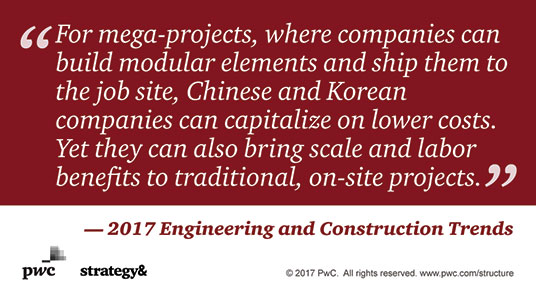Strategic Priorities
Engineering and Construction companies must overcome challenges in contracting and consolidation.
Companies in the engineering and construction (E&C) industry have had a rocky past few years, marked by slowdowns in most large energy projects, weak infrastructure spending in developed nations and less than robust markets for big residential and commercial buildings. Going forward, E&C firms will face a tougher environment – as evidenced by 3 major trends:
1) Contracting will get tougher. As competition for bids expands and clients become savvier about what projects should actually cost, demand for lump-sum, turnkey (LSTK) contracts (in which E&C firms bear the project cost risk and guarantee operational readiness) will accelerate. Many E&C firms are absorbing the risk while failing to effectively factor additional contingency costs into their bids – or build the requisite capabilities needed to operate in this new environment (project estimating, procurement hedging/fx).
Another challenge: Clients are breaking up larger projects into smaller, discrete elements that are awarded individually to the lowest bidder. Since these unbundled contracts encourage bottom feeding by construction companies, E&C companies risk losing the opportunity to subsidize less cost-effective areas of their operation with the profits from stronger areas.
Yet another factor complicating contracting is the growing popularity of public–private partnerships (PPPs), which require E&C firms to invest their own capital in exchange for a share of operational revenue from an infrastructure project down the road. This arrangement could put pressure on a construction company’s cash position and ability to support other growth activities – further, there’s a very real challenge for firms to figure out to develop the right level of funding from more rural projects.
2) Market consolidation will continue. Although in recent years, the volume of mergers and acquisitions in E&C has dropped – primarily owing to uncertainty about oil prices and infrastructure spending – we believe market consolidation will bounce back. For one thing, the recent industry downturn has hurt smaller firms much more than their larger and more diversified peers. Most of these smaller E&C firms have already taken steps to reduce overhead and transform their cost structure, leaving little fat left to cut. As a result, some of them may struggle to meet their debt covenants through 2020 and may not remain viable as stand-alone entities. Consequently, they may need to position themselves for an acquisition.
In addition, larger firms that survived the last few years now face pressure from shareholders, analysts, and other stakeholders to do more than stand still. In a flat market, consolidation is often the only way to find new revenue streams and diversify portfolios.
3) Competition will grow from E&C players in China, Korea, and India. Firms in rapidly growing economies in Asia have spent the past decade focusing on their home markets, building up cash positions and internal expertise. Now, as growth eases in their home markets, they are expanding outward and seeking to compete against established global players, particularly for large projects in developed markets.
For some mega-projects — particularly those for which companies can build modular elements at home and ship them to the job site for assembly — Chinese and Korean companies can capitalize on lower costs, making their bids more attractive. Given this dynamic, even when established construction companies win contracts, the margins are likely to be lower than what they have captured in the past.
In response to these three trends, construction firms should emphasize three strategic priorities.
Focus on the capabilities needed to succeed in the new market dynamic. As the shift to LSTK contracts occurs, construction firms need to get better at cost estimation, cost controls and procurement. Rather than simply tracking costs and passing them along to clients, they need to become proactive about identifying bloated costs and reducing them. Companies also need to adapt to changes in how their clients handle RFPs.
Understand your market — and identify opportunities to build scale. Management teams need to assess their operations vis a vis the competitive landscape – and determine whether the company has the scale needed to keep costs down and remain viable in the marketplace. For E&C firms that need to make deals, the ability to accurately evaluate potential targets faster than the competition will be essential. For example, some E&C firms are considering buying operations and maintenance (O&M) companies as a means of stabilizing their revenue. But a few high-profile O&M deals have closed in the last several years and prices are now significantly higher, skewing the potential advantages of such an acquisition.
Take a close look at your cost structure. The last strategic priority for E&C firms is to scrutinize costs carefully. Many legacy construction firms struggle to understand the elements of the cost issue today. They must recognize that technology is changing the design, procurement, and construction of projects to make processes more efficient and less expensive. Similarly, it may be hard for some leadership teams to assess the very real threat from new competition and to understand that changes in the industry require corresponding changes in their organizations.
For most E&C firms, taking on more risk and reevaluating their business models and cash flow structures in an environment that is not all that hospitable can be problematic. But given the industry challenges, the potential for new avenues for growth may be a better recipe for sustainable success than what companies in the industry have gotten used to.
Read Strategy&’s latest outlook on the trends shaping the engineering and construction sector here: https://www.strategyand.pwc.com/trend/2017-engineering-and-construction-trends.
Albert Kent and Mike Sobolewski are advisors to the engineering and construction industry with Strategy& PwC’s strategy consulting business, partners with PwC US.




